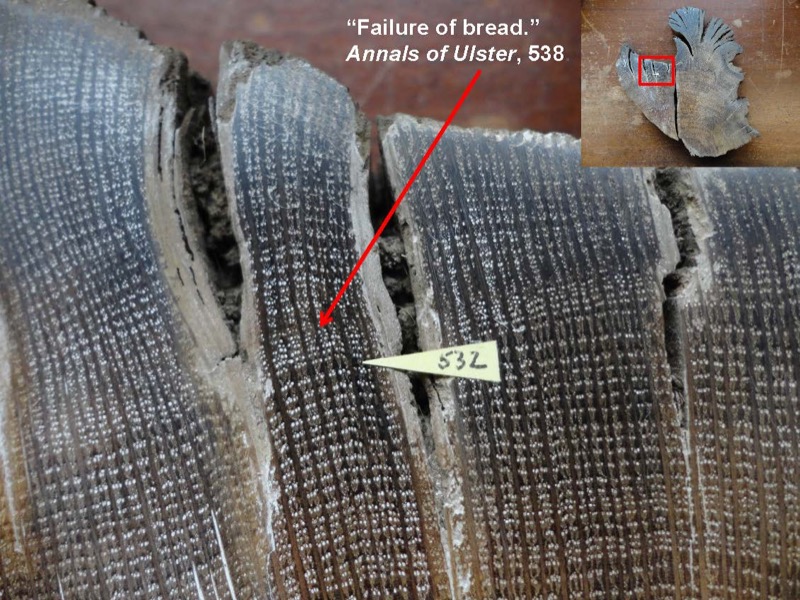Drought in the Dark Ages – a Catalyst for Crisis and Violence
Posted on: 20 April 2016
Periods of extreme drought in medieval Europe were associated with major societal stresses such as famine, disease and mass mortality, and evidence is emerging that they also had strong links to times of increased conflict and violence. As such, these periods of sudden climatic change were likely a key contribution to events that have shaped modern European societies.
Collaborative work involving researchers from Trinity College Dublin combined tree-ring evidence (one of the most reliable ways of assessing climatic conditions over millennia) with the rich written records of past societies across Europe to begin to pinpoint this systematic pattern.
Over the past five decades, scientists have been compiling records of annual oak tree-ring growth measurements that reflect spring and summer precipitation levels across Europe, but bringing these together into a single combined record has been a huge logistical feat.
Now, however, a large team of dendrochronologists and scientists, led by Professor Edward Cook, Columbia University, has taken on this task with the development and recent publication of the Old World Drought Atlas.
This for the first time makes available a robust reconstruction of spring-summer hydroclimatic conditions and extreme droughts for the greater European region, including the entirety of the Dark Ages of the first millennium, and is a resource that can now be drawn upon in both paleoclimatology and studies of climatic impacts on human society.
Already, the Atlas independently corroborates the existence and exceptional severity of droughts recorded in medieval European chronicles that have in the past been dismissed as gross exaggerations or even outright fabrications. Just one example is the “Great heat and drought [that] prevailed in this summer [of 1252 AD], so that people crossed the principal rivers of Ireland with dry feet. The reaping of the corn crops of Ireland was going on twenty days before Lammas [1 August], and the trees were scorched by the heat of the sun.” Annals of the Four Masters, 1252 AD.
The severity of such droughts is often greater than experienced in the modern period, and are linked in medieval societies to the spread of disease through the failure or crops, malnutrition and the movement of peoples in search of food. In 1575 AD, the Irish Annals record “Intense heat and extreme drought in the summer of this year; there was no rain for one hour, by night or day, from Bealtaine [1 May] to Lammas [1 August]. A loathsome disease and a dreadful malady arose from this heat, namely, the plague. This malady raged virulently among the Irish and English in Dublin, in Naas of Leinster, Ardee, Mullingar, and Athboy. Between those places many a castle was left without a guard, many a flock without a shepherd, and many a noble corpse without burial, in consequence of this distemper.” Annals of the Four Masters, 1575 AD. The Old World Drought Atlas confirms this summer as one of severe drought.

The exceptionally detailed record of conflict preserved in the Irish Annals, recorded on a continuous annual basis in medieval Irish monasteries for more than a millennium, also allowed the researchers to look for patterns in conjunction with periods of extreme drought identified in the Old World Drought Atlas. Even in this initial work, a recurring link was seen between increased recording of violence and conflict in the Irish Annals and drought conditions.
Severe drought also coincided with some of the most important conflicts in Irish History, including the 1014 AD Battle of Clontarf. This occurred in the context of a sudden and severe drought affecting almost the entirety of northwest Europe, of the kind known to have placed social and economic systems under great strain, a strain that also often influenced the political and military interactions between kingdoms and peoples.

Research Fellow in Trinity’s School of Histories and Humanities, Dr Francis Ludlow, presented this material at the European Geosciences Union General Assembly (EGU 2016).
Dr Ludlow said: “This combination of evidence from human archives like medieval chronicles and written archives like oak trees can help to advance our understanding of how climate played a role in human history, interacting with the many economic and political factors that have already been well studied by historians, archaeologists and other scholars.”
“Modern societies are certainly not invulnerable to sudden climatic shocks, though there is widespread complacency on this point. Clearly understanding how drought impacted human societies in the past has never been of greater importance, particularly in light of ongoing human interference in the global climate system."
Media Coverage
